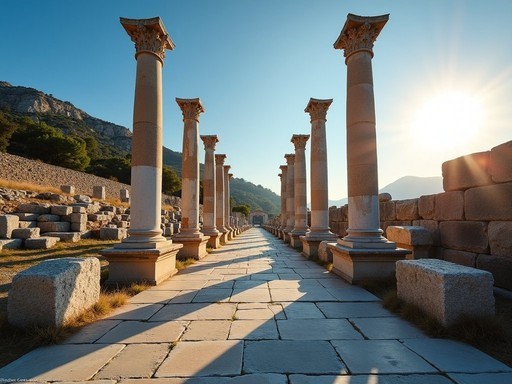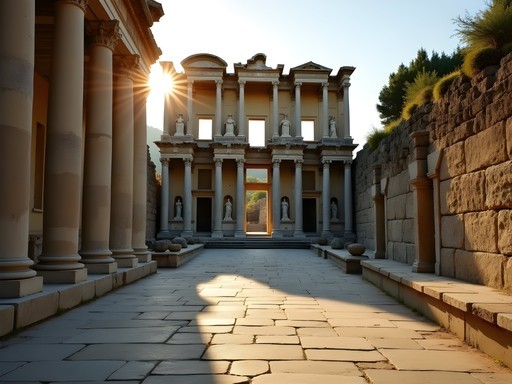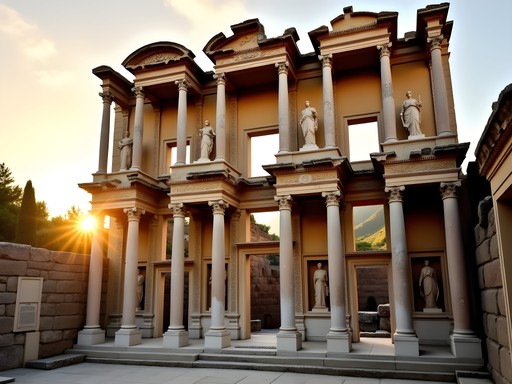Disclosure: This article contains affiliate links. We may earn a commission from purchases at no extra cost to you, which helps our travel content.
Standing at the entrance to Ephesus, watching the morning light illuminate the marble columns of this ancient metropolis, I couldn't help but slip into 'security mode' - scanning the landscape, observing the flow of visitors, and mentally mapping exit routes. Old habits from my Border Patrol days die hard. But this time, I wasn't securing a border - I was about to explore one of humanity's most impressive archaeological treasures. After 15 years with U.S. Border Patrol and countless trips documenting markets worldwide, I've developed a knack for reading places - their rhythms, their stories, their hidden corners. Turkey's ancient city of Ephesus offers more stories than most, with its remarkably preserved streets, grand monuments, and whispered secrets of a civilization long past. This spring weekend exploration would be different from my usual market adventures, but no less rich in cultural significance. Kia ora, fellow travelers - let's journey together through the magnificent ruins of Ephesus, where I'll share not just the history, but the practical insights that make a visit truly memorable.
Planning Your Visit to Ephesus
After years of navigating border checkpoints and crowded markets from Morocco to Thailand, I've learned that preparation is key to a smooth experience. Ephesus sits about 3 kilometers from Selçuk, a charming Turkish town that serves as the perfect base for exploration.
I arrived in Turkey via Izmir Airport, roughly an hour's drive from Selçuk. While public transportation options exist, I opted for a rental car to maximize flexibility and security - a habit from my Border Patrol days that's hard to shake. The drive is straightforward with well-marked roads, though having a good GPS device or reliable map app is essential as some signs are only in Turkish.
Accommodation in Selçuk ranges from budget hostels to boutique hotels. I chose the mid-range Ayasoluk Hotel, a family-run establishment with a rooftop terrace offering stunning views of St. John's Basilica. At around $70-90 USD per night in spring, it provided excellent value with its authentic Turkish breakfast and helpful staff.
Tickets to Ephesus cost 200 Turkish Lira (approximately $25 USD) as of my visit. I strongly recommend purchasing the Museum Pass Aegean if you're planning to visit multiple sites in the region - at 550 Lira, it quickly pays for itself with access to Ephesus, the Terrace Houses, Ephesus Museum, and several other nearby attractions.
One thing my security background has taught me: crowds can make or break an experience. Arriving at Ephesus by 8:00 AM when gates open puts you ahead of the tour buses that typically arrive around 9:30 AM. This early start granted me nearly empty pathways and unobstructed photos - a luxury that disappeared by mid-morning when the ancient streets became as crowded as a Bangkok night market.

💡 Pro Tips
- Purchase tickets online in advance to skip the queue
- Enter from the upper (north) gate and walk downhill through the site
- Wear sturdy walking shoes - the ancient marble streets are slippery when worn smooth
The Library of Celsus: Ephesus' Crown Jewel
If there's one image that defines Ephesus, it's the magnificent façade of the Library of Celsus. As I approached this architectural masterpiece, my training in observation revealed details that casual visitors might miss. The four female statues between the columns - Sophia (Wisdom), Episteme (Knowledge), Ennoia (Intelligence) and Arete (Virtue) - aren't just decorative. They're symbolic guardians of the intellectual treasure once housed within.
Built in 117 CE as both a library and mausoleum for Roman Senator Celsus Polemaeanus, this structure once held nearly 12,000 scrolls, making it one of the ancient world's most important knowledge repositories. The façade we see today is a careful reconstruction completed in the 1970s, but it loses none of its impact.
A security-minded tip: while most visitors crowd directly in front of the library for photos, I discovered that the best views (and most striking photographs) come from the slightly elevated path to the right of the façade. This position not only provides a unique angle but also escapes the worst of the crowds.
The interior space, though empty now, creates a natural acoustic chamber. Stand in the center and speak normally - your voice will amplify and echo in a way that suggests the architects understood sound engineering long before modern science defined it.
As a market specialist, I couldn't help but notice how the Library's position at the intersection of several main streets mirrors the strategic placement of important stalls in traditional bazaars - prime real estate meant to attract attention and foot traffic. Some patterns of human behavior haven't changed in two millennia.
I spent nearly an hour here, watching the changing light play across the marble façade while listening to my audio guide explain the intricate architectural details. The investment in a quality guidebook or audio tour truly enhances the experience, providing context that brings these ancient stones to life.

💡 Pro Tips
- Visit the Library twice - once in early morning light and again in late afternoon when the marble glows golden
- Look for the secret tunnel that once connected the Library to the brothel across the street
- Study the facial expressions on the statues - they convey different emotions based on your viewing angle
The Terrace Houses: A Glimpse into Elite Roman Life
While most visitors focus on Ephesus' grand public buildings, I found the Terrace Houses to be the most revealing part of the site. These residences of Ephesus' wealthy elite require a separate ticket (or are included with the Museum Pass), but the additional cost is more than justified.
Located opposite Hadrian's Temple on the slope of Mount Bulbul, these luxurious homes have been protected by modern roofing that creates a climate-controlled archaeological site. The preservation work here is ongoing, and watching archaeologists carefully piece together ancient frescoes reminded me of the artisans I've documented in markets worldwide - hands skilled in work that requires infinite patience.
As someone with Māori heritage, I'm particularly drawn to how cultures express themselves through their living spaces. The intricate mosaics underfoot tell stories of wealth and taste, while the sophisticated heating systems (hypocausts) beneath the floors speak to engineering ingenuity that wouldn't be matched again for centuries.
The houses are arranged in a terraced structure - hence the name - and connected by a series of stairways that climb the hillside. My Border Patrol experience made me appreciate the defensive aspects of this design; the layout provided natural security with limited access points and excellent visibility.
One particularly stunning room features a fresco depicting Socrates, still vibrant with color after nearly 2,000 years. I found myself reaching for my travel journal to sketch some of the geometric patterns that adorned the walls and floors - inspiration that would later influence my choices at Istanbul's Grand Bazaar.
The glass walkways installed throughout allow visitors to move through the houses without damaging the ancient floors, while providing views of the excavation layers below. It's a masterclass in archaeological presentation that makes the ancient world tangible.
The Terrace Houses require about 45-60 minutes to explore properly. The space can get warm during midday, so carrying water is essential. Photography is permitted without flash, though the reflective glass walkways can make capturing clear images challenging.

💡 Pro Tips
- Pay the extra fee for the Terrace Houses - they're the best-preserved Roman domestic buildings in the Mediterranean
- Look for the ancient graffiti scratched into some walls - even Romans had their rebellious teenagers
- Visit during midday when the houses' covered structure provides welcome shade from the sun
The Great Theater and Harbor Street
The Great Theater of Ephesus strikes me as the ancient equivalent of a modern stadium, capable of seating 25,000 spectators. As I climbed to the upper tiers, my security training kicked in - I found myself assessing crowd flow patterns and identifying potential bottlenecks, just as I would have done during large operations with Border Patrol.
This massive semicircular structure wasn't just for entertainment. It served as a gathering place for civic matters and, according to tradition, was where the silversmith Demetrius rallied fellow craftsmen against the apostle Paul, whose preaching threatened their trade in Artemis souvenirs. As someone who's documented artisans from Mexico to Morocco, I understand how deeply craft traditions intertwine with economic survival and cultural identity.
The theater's acoustics are remarkable - stand at the center of the stage and speak in a normal voice, and your words will carry clearly to the highest seats. This design predates modern sound engineering by millennia yet achieves what many contemporary venues require electronic assistance to accomplish.
From the theater, Harbor Street stretches toward where the ancient port once stood (now silted over and several kilometers from the sea). This broad, column-lined avenue was once Ephesus' commercial lifeline, connecting the city to maritime trade routes that spanned the Mediterranean. Walking its marble slabs, worn smooth by countless ancient footsteps, I imagined the merchants, sailors, and travelers who once crowded this thoroughfare - not unlike the market streets I've documented across the world.
Look down as you walk Harbor Street - you'll notice grooves worn into the marble from ancient cart wheels and clever innovations like raised stones that served as pedestrian crossings during rainy seasons when the street might flood. These practical details reveal a sophisticated urban planning that feels surprisingly modern.
At day's end, I found a quiet spot at the lower end of Harbor Street to rest and write in my travel notebook, capturing observations while they were fresh. The slanting afternoon light created dramatic shadows across the ancient stones, and the thinning crowds allowed moments of quiet reflection that connected me to the countless others who had passed this way before.

💡 Pro Tips
- Climb to the top tier of the theater for spectacular panoramic views of the entire archaeological site
- Visit the theater in late afternoon when the lighting is dramatic and the crowds have thinned
- Look for the subtle drainage systems along Harbor Street - evidence of sophisticated Roman engineering
Beyond the Main Site: Temple of Artemis and Ephesus Museum
Most visitors limit their Ephesus experience to the main archaeological park, but my security background has taught me to look beyond obvious boundaries. Two nearby sites provide crucial context that completes the Ephesus story: the Temple of Artemis and the Ephesus Museum in Selçuk.
The Temple of Artemis was once counted among the Seven Wonders of the Ancient World. Today, a single reconstructed column stands in a marshy field about 1 kilometer from Selçuk town center. The site initially seems underwhelming - especially compared to the grandeur of the main Ephesus complex. But standing there, trying to mentally reconstruct a temple once four times the size of the Parthenon, offers a powerful lesson in historical perspective and the impermanence of even our greatest achievements.
I visited at sunset when the golden light gave the lonely column an ethereal quality. A local farmer tending his fields nearby noticed my interest and approached to share stories passed down through generations about the temple's glory days. These unplanned encounters with local knowledge keepers often provide the most authentic insights - something I've found true from New Zealand markets to Turkish archaeological sites.
The Ephesus Museum in Selçuk houses many of the most significant artifacts recovered from the archaeological site. The famous statue of Artemis with her multiple breast-like protrusions (actually bull testicles, representing fertility) showcases how this Greek goddess was adapted to incorporate elements of earlier Anatolian mother goddesses - a fascinating example of cultural synthesis.
The museum's collection of everyday items - cooking utensils, children's toys, jewelry - provides intimate glimpses into ancient daily life that the grand architecture of the main site cannot. As someone who's documented craft traditions worldwide, I was particularly drawn to the displays of ancient workmanship - the delicate metalwork and intricate ivory carvings that demonstrate how skilled artisans have always found ways to transform raw materials into objects of beauty.
Allow at least two hours for the museum if you're genuinely interested in understanding Ephesus beyond its architectural remains. The building is air-conditioned - a welcome respite during hot spring afternoons - and the informative English placards provide excellent context for what you've seen at the main site.

💡 Pro Tips
- Visit the Temple of Artemis site at sunset for atmospheric photos of the lone column
- Combine your museum visit with lunch in Selçuk - Ejder Restaurant near the museum serves excellent authentic Turkish food
- Look for the gladiator tombstones in the museum - they reveal fascinating details about this ancient profession
Local Flavors: Where to Eat and Shop Near Ephesus
My years documenting market cultures worldwide have taught me that food and crafts often preserve traditions long after monuments have crumbled. The area around Ephesus offers rich opportunities to connect with local culture through both.
In Selçuk, several restaurants serve authentic regional cuisine that connects directly to ancient culinary traditions. My favorite discovery was Ejder Restaurant, where the owner proudly explained that their slow-cooked lamb with quince uses a recipe documented in Roman texts from Ephesus. The Ottoman-style courtyard setting creates an atmospheric backdrop for dishes that have evolved over centuries.
For a quicker meal, the small eateries near the lower gate of Ephesus offer simple but delicious gözleme (savory stuffed flatbreads) prepared by local women on traditional hot plates. Watching their practiced hands quickly flip the thin dough reminded me of craftspeople I've documented worldwide - the confidence that comes from skills passed through generations.
Speaking of craft traditions, the town of Selçuk hosts several workshops where artisans create items using techniques dating back to Ephesus' heyday. I spent a fascinating hour at Ephesus Ceramic Art Center, where the potter demonstrated how they recreate designs found on ancient pottery fragments using traditional methods. Their studio prices are considerably more reasonable than the tourist shops near the Ephesus gates.
For those interested in textiles, the nearby village of Şirince (about 8 kilometers from Selçuk) is known for traditional weaving. The drive there winds through picturesque hills covered with olive groves and vineyards. In the village, I discovered an elderly woman working a loom on her porch, creating intricate cotton towels using patterns her grandmother taught her. When traveling with my compact binoculars, I spotted her work from the village square and was able to appreciate the detailed craftsmanship before approaching.
Şirince is also famous for fruit wines - particularly unusual varieties like mulberry and quince. The free tastings offered by most shops provide a pleasant way to interact with local producers, though the wines themselves tend to be quite sweet for Western palates.
One security-minded tip: while the Ephesus region is generally very safe, the shops nearest to the archaeological site often engage in aggressive sales tactics. Prices there can be 3-4 times higher than identical items in Selçuk town. My Border Patrol experience taught me to maintain situational awareness in crowded tourist areas - a skill equally useful when navigating persistent salespeople.

💡 Pro Tips
- Ask for 'ev yemeği' (home cooking) in restaurants to try authentic family recipes rather than tourist versions
- Shop for souvenirs in Selçuk town rather than at the Ephesus gates for better prices and quality
- Visit Şirince in late afternoon after the day-trip crowds have departed for a more authentic experience
Final Thoughts
As I stood atop the theater at Ephesus watching the setting sun cast long shadows across ruins that have witnessed two millennia of human history, I felt that familiar sense of perspective that great archaeological sites inspire. From my years with Border Patrol to my current travels documenting market cultures, I've learned that understanding the past helps us navigate the present. Ephesus offers this understanding in abundance.
What makes this ancient city truly remarkable isn't just its impressive architecture or historical significance, but how it connects us to the everyday lives of people who walked these same marble streets centuries ago. Their theaters, homes, libraries, and marketplaces reveal concerns not so different from our own.
If you're planning a visit, give yourself at least a full day for the main site, plus another half-day for the museum and surrounding attractions. Come prepared for considerable walking, bring water, and arrive early to beat both the crowds and the heat. Most importantly, take moments to sit quietly amidst the ruins, allowing yourself to absorb the whispers of history that echo through these ancient stones. Kia ora and safe travels.
✨ Key Takeaways
- Ephesus rewards those who venture beyond the iconic Library of Celsus to explore less-visited sections like the Terrace Houses
- Spring offers ideal weather for exploration with fewer crowds than summer months
- The surrounding towns of Selçuk and Şirince provide authentic cultural experiences that complement the archaeological wonders
- A visit to both the main site and the Ephesus Museum provides the most complete understanding of this ancient city
📋 Practical Information
Best Time to Visit
April-May or September-October for mild weather and fewer crowds
Budget Estimate
$70-120 per day including accommodation, food, and entrance fees
Recommended Duration
1-2 full days
Difficulty Level
Moderate - Considerable Walking On Uneven Surfaces

















Comments
coolpro
How difficult is it to get to Ephesus from Istanbul? Thinking about adding it to our Turkey itinerary but not sure about logistics.
journeybackpacker
Not Taylor, but we flew from Istanbul to Izmir (about 1hr flight) then took a bus to Selçuk town which is right next to Ephesus. Super easy and definitely worth it!
coolpro
Thanks! That sounds doable. How many days would you recommend staying in the area?
journeybackpacker
We did 2 nights and it was perfect. One full day for Ephesus itself (it's huge!) and another half day to see the Temple of Artemis ruins and the local museum.
Casey Andersson
Taylor, this brought back so many memories! I visited Ephesus last summer and was equally mesmerized. One tip I'd add for luxury travelers - book a private guide for early morning (like 8am) before the cruise ships arrive. We practically had the Library of Celsus to ourselves for 20 glorious minutes! The Terrace Houses were definitely the highlight for me too - seeing those mosaic floors and frescoes preserved after all this time was mind-blowing. Did you get a chance to visit the Temple of Artemis site as well?
coollife
Is early morning really that much better? Planning my trip for next spring and wondering if it's worth the early wake-up call.
Casey Andersson
Absolutely! By 10am, the site gets crowded with tour groups. Early morning gives you better photos and a more peaceful experience. Plus, it's cooler temperature-wise!
hikingdiver
Wow, those photos of the Library of Celsus are incredible! The morning light really does make all the difference.
beachexplorer
Your photos of the Library of Celsus are stunning! We visited Ephesus last year and it was the highlight of our Turkey trip. One thing I'd add - the Terrace Houses are absolutely worth the extra entrance fee. The mosaics and frescoes are incredibly well-preserved, and the glass walkways let you see everything up close. We spent almost 2 hours just in that section! Also loved how you captured the sunset from the Great Theater - we did the same thing and it was magical watching the golden light on all that ancient marble. Did you make it to the nearby Temple of Artemis? Not much left but still worth a quick visit for history buffs.
happylover
Going there next month! How did you get from Selçuk to the ruins? Is it walkable or should we take a taxi?
beachexplorer
It's totally walkable from Selçuk! About 30 minutes on foot. We did it and enjoyed seeing the countryside. There are also dolmuş minibuses that run regularly if you don't want to walk.
happylover
Perfect, thanks so much! We'll probably walk there and maybe take a minibus back if we're tired.
Hunter Thompson
Amazing post Taylor! I visited Ephesus last summer and it blew my mind. One tip for anyone planning to go - arrive SUPER early (like 8am when they open) or go late afternoon around 3-4pm. We got there at 10am and it was packed with cruise ship tours. The Library of Celsus is incredible but hard to photograph without crowds unless you time it right. Also, bring water! There's barely any shade and it gets brutally hot. I filled my water bottle about 3 times while there. The walk from the upper entrance to the lower exit is all downhill, which is much easier than going the opposite direction!
beachexplorer
We did the early morning thing and it was perfect! Got some amazing photos before the crowds arrived. Definitely worth setting an alarm for.
sunsetchamp
Those terrace houses look incredible! Definitely adding this to my bucket list.
Hunter Thompson
They're absolutely worth it! Make sure you pay the extra fee to see them - most tourists skip them but they're the highlight!
sunsetchamp
Thanks for the tip! Will definitely make sure to see them when I go.
hikingpro
Just got back from Ephesus last week and your guide was super helpful! One thing I'd add - wear proper shoes with good grip. Some of those marble streets are SLIPPERY, especially if there's been any rain. We saw multiple people slip and fall. Also, the walk from the upper entrance down to the lower exit is much easier than going the opposite direction. We spent about 4 hours exploring and that felt about right to see everything without rushing.
photoking
That shot of the Library of Celsus is stunning! What time did you take it to get that perfect lighting?
Taylor Hunter
Thanks! That was around 9am in early spring. The morning light hits the façade perfectly then. If you're there in summer, you might need to go even earlier.
photoking
Perfect, thanks! Adding this to my shot list for our Turkey trip next year.
Douglas Bradley
Excellent write-up on Ephesus! I visited last year and found the Terrace Houses to be the absolute highlight - worth every extra lira for the separate ticket. The preservation of the mosaics and frescoes is remarkable, and the ongoing archaeological work is fascinating to observe. One tip I'd add: bring a good guidebook or hire one of the licensed guides at the entrance. The historical context they provide transforms the experience from simply seeing impressive ruins to truly understanding the sophisticated urban center Ephesus once was. I used Rick Steves Turkey which had excellent walking tour notes for self-guided exploration.
hikingpro
Totally agree about the Terrace Houses! We almost skipped them but they ended up being the best part of our visit. The glass walkways over the excavations give such a unique perspective.
Venture X
Premium card with 2X miles, $300 travel credit, Priority Pass